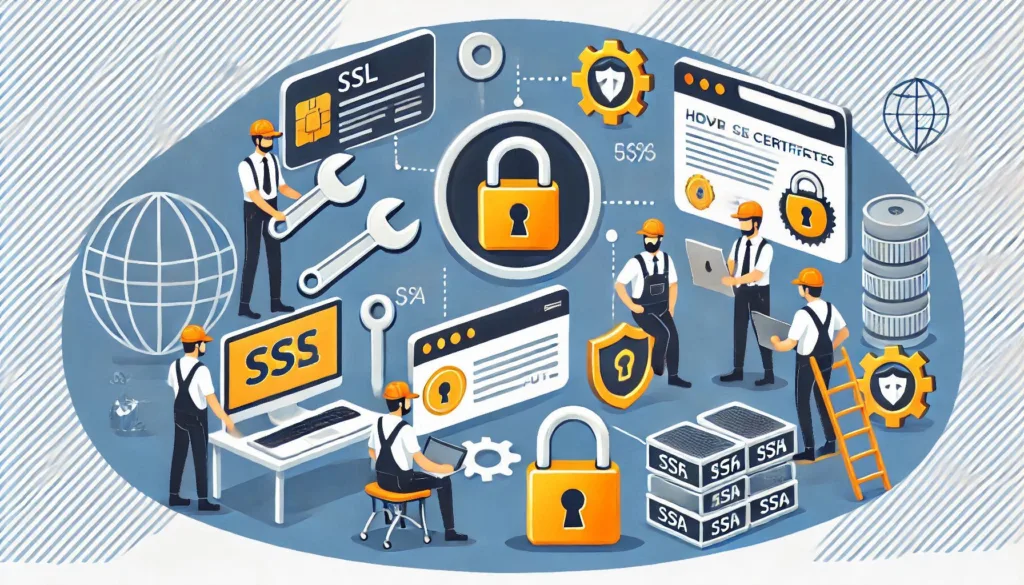How SSL Certificates Work
An SSL certificate secures communication between a user’s browser and a web server by encrypting data. Here’s a breakdown of how it works step-by-step:

Table of Contents

1. Handshake Process
The process starts when a browser requests a secure connection with a website:
Step 1: Browser Request
- The user types a URL or clicks a link that starts with
https://. - The browser contacts the website server and requests a secure connection.
Step 2: Server Sends SSL Certificate
- The server responds by sending its SSL certificate to the browser.
- The certificate contains:
- The server’s public key.
- Information about the website’s identity (domain, organization, issuer).
- The certificate’s expiration date.
- The issuing Certificate Authority (CA).
Step 3: Certificate Validation
- The browser checks the SSL certificate’s validity by:
- Verifying the certificate’s digital signature against the CA’s public key.
- Ensuring the certificate hasn’t expired.
- Confirming that the certificate matches the domain.
Step 4: Key Exchange
- Once the certificate is validated, the browser and server initiate a key exchange.
- The server shares its public key with the browser, which uses it to generate a session key.
- The session key is encrypted using the server’s public key and sent back to the server.
Step 5: Encrypted Communication
- The server decrypts the session key using its private key.
- From this point, both browser and server use the session key to encrypt and decrypt data.
2. Data Encryption
Once the handshake is complete:
- All communication between the browser and the server is encrypted.
- Sensitive information, such as login credentials, credit card details, and personal data, is secured.
Example: Encryption in Action
- User enters a password:
mypassword123. - The browser encrypts it (e.g.,
@s7c#v1Z). - The server decrypts it back to
mypassword123using the session key.
3. Digital Signatures
SSL certificates also ensure authentication and integrity:
- The certificate contains a digital signature from the CA.
- This signature confirms that the website is trustworthy and the certificate hasn’t been tampered with.
How Digital Signatures Work:
- The CA signs the certificate using its private key.
- The browser verifies the signature using the CA’s public key.
- If valid, the browser trusts the SSL certificate.
4. Trust Chain
SSL certificates rely on a “chain of trust”:
- The browser trusts root certificates issued by trusted Certificate Authorities (CAs).
- The CA verifies and issues intermediate certificates.
- The website’s SSL certificate is issued by these intermediates, linking it back to the trusted root.
If the Chain is Broken:
- Browsers display a warning: “Your connection is not private.”
- This usually happens if the certificate is expired, self-signed, or issued by an untrusted CA.
5. Types of Encryption Used
SSL uses two types of encryption:
- Asymmetric Encryption:
- Used during the handshake.
- Involves a public key (shared) and a private key (kept secret).
- Symmetric Encryption:
- Used after the handshake for faster data transfer.
- Both browser and server use the same session key.
Key Benefits of SSL Certificates
- Data Security: Protects sensitive information through encryption.
- Authentication: Confirms the website’s identity.
- Trust and SEO: Builds trust with users and improves search engine rankings.
- Data Integrity: Ensures data is not tampered with during transmission.
Certainly! Here’s the continuation:
6. What Happens Without an SSL Certificate?
If a website does not have an SSL certificate:
- Unsecured Connection:
- Data sent between the user and the website is transmitted in plain text.
- Hackers can intercept this data using tools like packet sniffers.
- Browser Warnings:
- Modern browsers display warnings like “Not Secure” in the address bar for sites without HTTPS.
- Users are likely to abandon such websites due to security concerns.
- SEO Penalty:
- Google and other search engines prioritize websites with SSL certificates in search rankings.
- Websites without SSL may rank lower.
- Loss of Trust:
- Customers are less likely to interact with or make purchases on unsecured websites.
7. Practical Uses of SSL Certificates
SSL certificates are used in various scenarios to protect online communication:
1. E-commerce Websites:
- Protects sensitive payment information like credit card numbers.
- Builds trust with customers by securing transactions.
2. Login Pages:
- Encrypts login credentials to protect user accounts from being compromised.
3. Email Services:
- Ensures that emails sent through a webmail interface are encrypted.
4. Government Websites:
- Safeguards sensitive citizen data during interactions with official portals.
5. File Transfers:
- Secures data exchange between systems, such as uploading files to a cloud service.
8. Importance of Regular SSL Updates
SSL certificates are not a one-time setup. Maintaining and updating them is crucial for security:
- Renew Certificates Before Expiry:
- Expired SSL certificates cause browser warnings and disrupt secure connections.
- Upgrade to the Latest Protocols:
- SSL has evolved to TLS (Transport Layer Security), which offers stronger encryption.
- Ensure your server uses the latest TLS version (currently TLS 1.3).
9. SSL vs. TLS
Although often used interchangeably, SSL (Secure Sockets Layer) and TLS (Transport Layer Security) are different:
- SSL: An older protocol, now largely deprecated.
- TLS: The modern standard for encryption, offering enhanced security.
- TLS 1.3 is the latest version, providing faster performance and stronger encryption than TLS 1.2.
10. Summary: Why SSL Certificates Are Essential
- Data Protection: Keeps user data safe from interception.
- Authentication: Verifies the website’s identity, ensuring users are not redirected to malicious sites.
- SEO Advantage: Helps improve search rankings and user trust.
- Compliance: Meets industry regulations like GDPR, HIPAA, and PCI DSS.
By understanding how SSL certificates work and their importance, businesses and website owners can ensure secure and trustworthy online experiences for their users. If you need help selecting or setting up an SSL certificate, feel free to ask!

what is ssl certificate for domain
What is an SSL Certificate for a Domain?
An SSL certificate for a domain is a digital certificate that encrypts data exchanged between a user’s web browser and a specific domain’s web server. It ensures that all communication, including personal data and sensitive information, is kept secure and private.
How SSL Certificates Work for Domains
When you install an SSL certificate on your domain, it activates the HTTPS protocol, which means your website will be secure. Here’s how it functions:
- Encryption:
- The SSL certificate encrypts the data between the user’s browser and the web server. This ensures that any information transmitted (such as passwords, payment details, etc.) is unreadable to unauthorized parties.
- Authentication:
- The SSL certificate confirms that the website is legitimate and not an imposter. This helps prevent phishing attacks and confirms the identity of the website to the users.
- Data Integrity:
- SSL ensures that data is not tampered with during transmission. It guarantees that the data sent from the user to the server, and vice versa, remains intact.
Types of SSL Certificates for Domains
There are various types of SSL certificates depending on the level of validation and the number of domains you want to secure:
1. Domain Validated (DV) SSL Certificate:
- Purpose: Verifies domain ownership.
- Suitable For: Personal websites, blogs, or any site that doesn’t require the highest level of validation.
- Features: Quick to issue; basic encryption.
2. Organization Validated (OV) SSL Certificate:
- Purpose: Verifies domain ownership and the legitimacy of the organization.
- Suitable For: Business websites or e-commerce stores.
- Features: Provides more trust with users by displaying the organization’s details in the certificate.
3. Extended Validation (EV) SSL Certificate:
- Purpose: The most rigorous level of validation, verifying both domain ownership and detailed organization information.
- Suitable For: E-commerce sites, financial institutions, and any business requiring a high level of user trust.
- Features: Shows the organization’s name in the address bar (e.g., Green Bar), offering the highest level of trust.
4. Wildcard SSL Certificate:
- Purpose: Secures a domain and all its subdomains (e.g.,
www.example.com,blog.example.com). - Suitable For: Websites with multiple subdomains.
- Features: One SSL certificate for unlimited subdomains.
5. Multi-Domain SSL Certificate (SAN SSL):
- Purpose: Secures multiple domains and subdomains under one certificate (e.g.,
example.com,example.net). - Suitable For: Businesses with several websites or domains.
- Features: One certificate for multiple domains.
How to Get an SSL Certificate for Your Domain
- Choose a Certificate Authority (CA):
- Select a trusted Certificate Authority (CA) like Let’s Encrypt (free), Comodo, Symantec, or DigiCert.
- Generate a CSR (Certificate Signing Request):
- On your server, generate a CSR that includes your domain details. This is required for obtaining the SSL certificate.
- Purchase and Validate:
- Purchase an SSL certificate (if not using a free option like Let’s Encrypt).
- For paid certificates, you’ll need to provide proof of ownership and identity, depending on the certificate type.
- Install the SSL Certificate:
- Once your certificate is issued, install it on your server. This typically involves uploading the certificate files to your hosting provider or server.
- Activate HTTPS:
- After installing the certificate, configure your website to use HTTPS by updating links and redirecting HTTP traffic to HTTPS.

Benefits of Using an SSL Certificate for Your Domain
- Improved Security: Encrypts data transferred between the user and your website, making it difficult for hackers to intercept or steal sensitive information.
- Trust and Credibility: Users are more likely to trust a website with SSL, as it shows the site is secure. This trust can lead to higher conversion rates for e-commerce sites.
- SEO Boost: Google prioritizes secure websites with HTTPS in search rankings, which means SSL certificates can help improve your SEO.
- Compliance: Many regulations (like GDPR, PCI DSS) require that websites use SSL to protect user data.
How to Check If a Domain Has an SSL Certificate
- Look for HTTPS: In the browser’s address bar, check for
https://before the domain name. This means the site has an SSL certificate. - Padlock Icon: A padlock symbol appears next to the domain name in the address bar, indicating the site is secure.
- Click the Padlock: Clicking the padlock will show information about the certificate, including who issued it and the domain it’s issued for.
Free SSL Certificate for Your Domain
You can obtain free SSL certificates for your domain through services like Let’s Encrypt, which offer simple and automated installation for securing domains.
Steps to Get a Free SSL Certificate:
- Choose a hosting provider that supports Let’s Encrypt.
- Activate the free SSL certificate via the hosting control panel (like cPanel).
- Let’s Encrypt automatically installs the certificate and sets up HTTPS.
Conclusion
An SSL certificate for your domain is essential for securing online communications, building trust with visitors, and improving your website’s SEO. Whether you’re running a blog or an e-commerce site, securing your domain with SSL ensures that your users’ data remains private and protected.
If you need help with the process or have more specific questions, feel free to ask!


